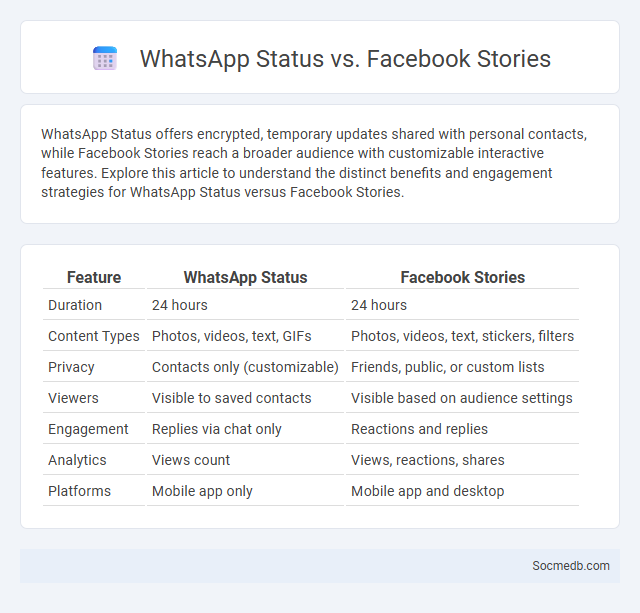
Photo illustration: WhatsApp Status vs Facebook Stories
WhatsApp Status offers encrypted, temporary updates shared with personal contacts, while Facebook Stories reach a broader audience with customizable interactive features. Explore this article to understand the distinct benefits and engagement strategies for WhatsApp Status versus Facebook Stories.
Table of Comparison
| Feature | WhatsApp Status | Facebook Stories |
|---|---|---|
| Duration | 24 hours | 24 hours |
| Content Types | Photos, videos, text, GIFs | Photos, videos, text, stickers, filters |
| Privacy | Contacts only (customizable) | Friends, public, or custom lists |
| Viewers | Visible to saved contacts | Visible based on audience settings |
| Engagement | Replies via chat only | Reactions and replies |
| Analytics | Views count | Views, reactions, shares |
| Platforms | Mobile app only | Mobile app and desktop |
Introduction: The Rise of Social Media Status Sharing
Social media status sharing has revolutionized digital communication by enabling real-time expression of personal experiences, opinions, and emotions across platforms like Facebook, Instagram, and Twitter. This trend has significantly increased user engagement, fostering widespread connectivity and influencing social behavior worldwide. As a result, status updates have become powerful tools for shaping online identity and driving viral content.
What is WhatsApp Status?
WhatsApp Status is a feature that allows users to share photos, videos, text, and GIF updates with their contacts for 24 hours, providing a dynamic way to express moments and thoughts. Your WhatsApp Status is visible only to selected contacts based on your privacy settings, offering control over who sees your updates. This feature enhances personal communication and engagement within the WhatsApp ecosystem by sharing real-time, temporary content.
Understanding Facebook Stories
Facebook Stories offer a dynamic way to share moments with your network through photos and short videos that disappear after 24 hours, enhancing engagement with real-time content. Understanding how to use interactive features like polls, stickers, and location tags can significantly boost visibility and connect your message to a wider audience. Mastering Facebook Stories empowers your brand or personal profile to communicate authentically and maintain consistent audience interaction.
Defining Traditional Status Updates
Traditional status updates on social media platforms, such as Facebook and Twitter, are brief posts that convey users' current thoughts, activities, or emotions to their network. These updates typically include text, sometimes accompanied by images or links, and serve to maintain social connections by sharing personal experiences in real-time. The defining characteristic of traditional status updates lies in their temporal relevance and simplicity, distinguishing them from more complex posts like long-form content or multimedia stories.
Key Features Comparison
Social media platforms like Facebook, Instagram, Twitter, and LinkedIn differ significantly in their core features, targeting various user needs such as networking, content sharing, and professional growth. Facebook prioritizes comprehensive social networking with extensive groups and event features, while Instagram emphasizes visual content through stories, reels, and photo posts. Twitter focuses on real-time news and microblogging with its character limit and trending topics, whereas LinkedIn specializes in professional networking, offering job postings, endorsements, and industry-specific content.
Privacy and Audience Controls
Social media platforms implement robust privacy and audience controls to empower users in managing who can view their content and personal information. Features such as customizable privacy settings, audience selectors, and content visibility options ensure that users can restrict access to profiles, posts, and shared data. These tools help protect user privacy while enhancing control over digital interactions and information sharing.
Engagement and Interaction Differences
Engagement on social media varies significantly by platform, with Instagram promoting high visual interaction through likes, comments, and story reactions, while Twitter emphasizes real-time conversation and retweets. Facebook's engagement metrics combine reactions, shares, and extensive comment threads, encouraging deeper interaction within community groups. TikTok excels in short-form video engagement, driving user interaction via duets, stitches, and viral trends, highlighting diverse behavioral patterns in digital communication.
Use Cases: When to Use Each Feature
Social media platforms offer diverse features tailored for specific use cases such as brand promotion, customer engagement, and real-time communication. Stories on Instagram and Facebook excel for ephemeral updates and immersive visual content, while Twitter threads are ideal for sharing timely news and ongoing conversations. LinkedIn's professional groups and live video tools serve best in networking and industry-specific knowledge sharing.
Pros and Cons Overview
Social media platforms enhance communication by enabling instant connectivity, fostering community building, and providing valuable marketing opportunities for businesses. However, they also pose risks such as privacy breaches, cyberbullying, and the spread of misinformation, which can negatively impact mental health and societal trust. Balancing these advantages and disadvantages is crucial for maximizing social media's benefits while minimizing its harms.
Conclusion: Which Status Feature Suits You Best?
Choosing the ideal social media status feature depends on your personal communication style and audience engagement goals. If you prefer quick, casual updates, ephemeral stories offer dynamic and real-time sharing, while permanent status posts provide lasting visibility for important announcements. Evaluating platform-specific features like interactive polls or multimedia options helps tailor your social media presence for maximum impact and connection.
 socmedb.com
socmedb.com